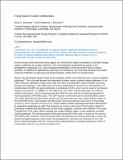| dc.contributor.author | Andorfer, Mary | |
| dc.contributor.author | Drennan, Catherine L | |
| dc.date.accessioned | 2021-08-24T20:09:35Z | |
| dc.date.available | 2021-08-24T20:09:35Z | |
| dc.date.issued | 2021-04 | |
| dc.identifier.issn | 2542-4351 | |
| dc.identifier.uri | https://hdl.handle.net/1721.1/131195 | |
| dc.description.abstract | Conversion of C₂ to C₃ compounds is used by nature in abundant processes such as photorespiration but comes at the cost of CO₂ release. Erb and co-workers recently published an article in Nature Catalysis describing a synthetic pathway able to convert C₂ to C₃ compounds through a carbon fixation step. | en_US |
| dc.language.iso | en | |
| dc.publisher | Elsevier BV | en_US |
| dc.relation.isversionof | http://dx.doi.org/10.1016/j.joule.2021.03.025 | en_US |
| dc.rights | Creative Commons Attribution-NonCommercial-NoDerivs License | en_US |
| dc.rights.uri | http://creativecommons.org/licenses/by-nc-nd/4.0/ | en_US |
| dc.source | Prof. Drennan | en_US |
| dc.title | Fixing nature’s carbon inefficiencies | en_US |
| dc.type | Article | en_US |
| dc.identifier.citation | Andorfer, Mary C. and Catherine L. Drennan. "Fixing nature’s carbon inefficiencies." Joule 5, 4 (April 2021): P765-767. © 2021 Elsevier Inc | en_US |
| dc.contributor.department | Massachusetts Institute of Technology. Department of Biology | en_US |
| dc.contributor.department | Massachusetts Institute of Technology. Department of Chemistry | en_US |
| dc.relation.journal | Joule | en_US |
| dc.eprint.version | Author's final manuscript | en_US |
| dc.type.uri | http://purl.org/eprint/type/JournalArticle | en_US |
| eprint.status | http://purl.org/eprint/status/PeerReviewed | en_US |
| dc.date.updated | 2021-08-09T14:10:37Z | |
| dspace.orderedauthors | Andorfer, MC; Drennan, CL | en_US |
| dspace.date.submission | 2021-08-09T14:10:40Z | |
| mit.journal.volume | 5 | en_US |
| mit.journal.issue | 4 | en_US |
| mit.license | PUBLISHER_CC | |
| mit.metadata.status | Complete | |
